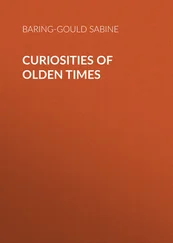Sabine Baring-Gould - Strange Survivals
Здесь есть возможность читать онлайн «Sabine Baring-Gould - Strange Survivals» — ознакомительный отрывок электронной книги совершенно бесплатно, а после прочтения отрывка купить полную версию. В некоторых случаях можно слушать аудио, скачать через торрент в формате fb2 и присутствует краткое содержание. Жанр: foreign_antique, foreign_prose, на английском языке. Описание произведения, (предисловие) а так же отзывы посетителей доступны на портале библиотеки ЛибКат.
- Название:Strange Survivals
- Автор:
- Жанр:
- Год:неизвестен
- ISBN:нет данных
- Рейтинг книги:4 / 5. Голосов: 1
-
Избранное:Добавить в избранное
- Отзывы:
-
Ваша оценка:
- 80
- 1
- 2
- 3
- 4
- 5
Strange Survivals: краткое содержание, описание и аннотация
Предлагаем к чтению аннотацию, описание, краткое содержание или предисловие (зависит от того, что написал сам автор книги «Strange Survivals»). Если вы не нашли необходимую информацию о книге — напишите в комментариях, мы постараемся отыскать её.
Strange Survivals — читать онлайн ознакомительный отрывок
Ниже представлен текст книги, разбитый по страницам. Система сохранения места последней прочитанной страницы, позволяет с удобством читать онлайн бесплатно книгу «Strange Survivals», без необходимости каждый раз заново искать на чём Вы остановились. Поставьте закладку, и сможете в любой момент перейти на страницу, на которой закончили чтение.
Интервал:
Закладка:
We come now to another point, the gable apex. A gable, of course, is and must be an inverted v ,  ; but there are just three ways in which the apex can be treated. When the principals are first erected they form an x ,
; but there are just three ways in which the apex can be treated. When the principals are first erected they form an x ,  , the upper limbs shorter than the lower. Sometimes they are so left. But sometimes they are sawn off, and are held together by mortices into an upright piece of timber. Then the gable represents an inverted
, the upper limbs shorter than the lower. Sometimes they are so left. But sometimes they are sawn off, and are held together by mortices into an upright piece of timber. Then the gable represents an inverted  . If the ends are sawn off, and there be no such upright, then there remains an inverted v , but, to prevent the rotting of the ends at the apex, a crease like a small v is put over the juncture,
. If the ends are sawn off, and there be no such upright, then there remains an inverted v , but, to prevent the rotting of the ends at the apex, a crease like a small v is put over the juncture,  . These are the only three variations conceivable. The last is the latest, and dates from the introduction of lead, or of tile ridges. By far the earliest type is the simplest, the leaving of the protruding ends of the principals forming
. These are the only three variations conceivable. The last is the latest, and dates from the introduction of lead, or of tile ridges. By far the earliest type is the simplest, the leaving of the protruding ends of the principals forming  . Then, to protect these ends from the weather, to prevent the water from entering the grain, and rotting them, they were covered with horse-skulls, and thus two horse-skulls looking in opposite directions became an usual ornament of the gable of a house. Precisely the same thing was done with the tie-beams that protruded under the eaves. These also were exposed with the grain to the weather, though not to the same extent as the principals. They also were protected by skulls being fastened over their ends, and these skulls at the end of the tie-beams are the prototypes of the corbel-heads round old Norman churches.
. Then, to protect these ends from the weather, to prevent the water from entering the grain, and rotting them, they were covered with horse-skulls, and thus two horse-skulls looking in opposite directions became an usual ornament of the gable of a house. Precisely the same thing was done with the tie-beams that protruded under the eaves. These also were exposed with the grain to the weather, though not to the same extent as the principals. They also were protected by skulls being fastened over their ends, and these skulls at the end of the tie-beams are the prototypes of the corbel-heads round old Norman churches.
Among the Anglo-Saxons the  gable was soon displaced by that shaped like
gable was soon displaced by that shaped like  , if we may judge by early illustrations, but the more archaic and simple construction prevailed in North Germany and in Scandinavia. To the present day the carved heads are affixed to the ends of the principals, and these heads take the place of the original skulls. The gable of the Horn Church in Essex has got an ox’s head with horns on it.
, if we may judge by early illustrations, but the more archaic and simple construction prevailed in North Germany and in Scandinavia. To the present day the carved heads are affixed to the ends of the principals, and these heads take the place of the original skulls. The gable of the Horn Church in Essex has got an ox’s head with horns on it.
In one Anglo-Saxon miniature representing a nobleman’s house, a stag’s head is at the apex. The old Norwegian wooden church of Wang of the twelfth century, which was bought and transported to the flanks of the Schnee-Koppe in Silesia by Frederick William IV. in 1842, is adorned with two heads of sea-snakes or dragons, one at each end of the gable. In the Rhætian Alps the gables of old timber houses have on them the fore-parts of horses, carved out of the ends of the intersecting principals.
But the horse’s head, sometimes even a human skull, was also affixed to the upright leg of the inverted y – the hipknob, 6 6 Herodotus, iv. 103: “Enemies whom the Scythians have subdued they treat as follows: each having cut off a head, carries it home with him, then hoisting it on a long pole, he raises it above the roof of his house – and they say that these act as guardians to the household.”
as architects term it – partly, no doubt, as a protection of the cross-cut end from rain and rotting. But though there was a practical reason for putting skulls on these exposed timber-ends, their use was not only practical, they were there affixed for religious reasons also, and indeed principally for these.
As a sacrifice was offered when the foundations of a house were laid, so was a sacrifice offered when the roof was completed. The roof was especially subject to the assaults of the wind, and the wind was among the Northmen and Germans, Odin, Woden, or Wuotan. Moreover, in high buildings, there was a liability to their being struck by lightning, and the thunder-god Thorr had to be propitiated to stave off a fire. The farmhouses in the Black Forest to the present day are protected from lightning by poles with bunches of flowers and leaves on the top, that have been carried to church on Palm Sunday, and are then taken home and affixed to the gable, where they stand throughout the year. The bunch represents the old oblation offered annually to the God of the Storm. 7 7 The floreated points of metal or stone at the apex of a gable are a reminiscence of the bunch of grain offered to Odin’s horse.
Horses were especially regarded as sacred animals by the Germans, the Norsemen, and by the Slaves. Tacitus tells us that white horses were kept by the ancient Germans in groves sacred to the gods; and gave auguries by neighing. The Icelandic sagas contain many allusions to the old dedication of horses to the gods. Among the Slaves, horses were likewise esteemed sacred animals; swords were planted in the ground, and a horse was led over them. Auguries were taken by the way in which he went, whether avoiding or touching the blades. In like manner the fate of prisoners was determined by the actions of an oracular horse. When a horse was killed at a sacrifice, its flesh was eaten. St. Jerome speaks of the Vandals and other Germanic races as horse-eaters, and St. Boniface forbade his Thuringian converts to eat horse-flesh.
The eating of this sort of meat was a sacramental token of allegiance to Odin. When Hakon, Athelstan’s foster-son, who had been baptised in England, refused to partake of the sacrificial banquet of horse-flesh at the annual Council in Norway, the Bonders threatened to kill him. A compromise was arrived at, so odd that it deserves giving in the words of the saga: “The Bonders pressed the King strongly to eat horse-flesh; and as he would not do so, they wanted him to drink the soup; as he declined, they insisted that he should taste the gravy; and on his refusal, were about to lay hands on him. Earl Sigurd made peace by inducing the King to hold his mouth over the handle of the kettle upon which the fat steam of the boiled horse-flesh had settled; and the King laid a linen cloth over the handle, and then gaped above it, and so returned to his throne; but neither party was satisfied with this.” This was at the harvest gathering. At Yule, discontent became so threatening, that King Hakon was forced to appease the ferment by eating some bits of horse’s liver.
Giraldus Cambrensis says of the Irish that in Ulster a king is thus created: “A white mare is led into the midst of the people, is killed, cut to pieces and boiled; then a bath is prepared of the broth. Into this the King gets, and sitting in it, he eats of the flesh, the people also standing round partake of it. He is also required to drink of the broth in which he has bathed, lapping it with his mouth.” (“Topography of Ireland,” c. xxv.) This is, perhaps, the origin of the Irish expression, “a broth of a boy.”
Tacitus tells us that after a defeat of the Chatti, their conquerors sacrificed horses, ate their flesh, and hung up their heads in trees, or affixed them to poles, as offerings to Wuotan. So, after the defeat of Varus and his legions, when Cæcina visited the scene of the disaster, he found the heads of the horses affixed to the branches and trunks of the trees. Gregory the Great, in a letter to Queen Brunehild, exhorted her not to suffer the Franks thus to expose the heads of animals offered in sacrifice. At the beginning of the fifth century, St. Germanus, who was addicted to the chase before he was made Bishop of Auxerre, was wont to hang up the heads and antlers of the game killed in hunting in a huge pear-tree in the midst of Auxerre, as an oblation to Odin, regardless of the reproof of his bishop, Amator, who, to put an end to this continuance of a heathenish ceremony, cut down the tree.
Читать дальшеИнтервал:
Закладка:
Похожие книги на «Strange Survivals»
Представляем Вашему вниманию похожие книги на «Strange Survivals» списком для выбора. Мы отобрали схожую по названию и смыслу литературу в надежде предоставить читателям больше вариантов отыскать новые, интересные, ещё непрочитанные произведения.
Обсуждение, отзывы о книге «Strange Survivals» и просто собственные мнения читателей. Оставьте ваши комментарии, напишите, что Вы думаете о произведении, его смысле или главных героях. Укажите что конкретно понравилось, а что нет, и почему Вы так считаете.












